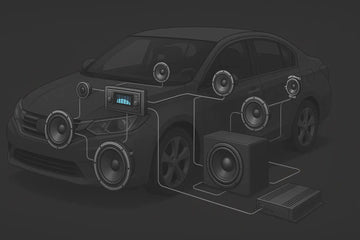Key Highlights
- This guide provides a comprehensive understanding of car audio systems, perfect for beginners.
- Learn about the different components of a car audio system and common terminology.
- We guide you through assessing your current setup and defining your audio goals.
- Discover simple steps to upgrade your car audio, from choosing a stereo to adding a subwoofer.
- Find answers to frequently asked questions about car stereos, amplifiers, and more.
Introduction
For many people, a car audio system is a big part of their love for music and driving experience. But the car audio world can feel confusing because of the tricky terms and many parts. This simple guide will break down the basics of car audio. It will help you understand, assess, and improve your car's audio system.
Understanding Car Audio Systems: A Primer

A car audio system is made to play sound inside your car. It takes audio from different sources, like your radio, CD player, or smartphone, boosts it, and sends it to the speakers so you can enjoy the music.
This system usually has a few key parts that work together. These parts include a head unit, which is the car stereo, speakers, and an amplifier. Some systems also have a subwoofer that provides extra bass. Knowing how these parts work and connect is important to improve your car's sound system.
The Components of a Car Audio System
Your car's factory stereo system is a good starting point, but there is often room to improve it. Here is a look at the key parts:
- Head Unit: This is the main control center of your car audio system. It is found in your dashboard. It includes the radio tuner, CD player (if you have one), and spots for connecting other audio sources, like Bluetooth, USB, or auxiliary ports.
- Speakers: These convert electrical signals from the amplifier into sound you can hear. They come in different sizes and styles, but full-range speakers are the most common.
- Amplifier: This boosts the electrical signal from the head unit. It gives the power to make the speakers work well and create clear, loud audio.
Common Car Audio Terminology Explained
Navigating car audio can feel like learning a new language. Here are some common terms you might see:
- HD Radio: This gives you digital radio with better sound quality. You also get extra program info compared to regular FM radio.
- CD Player: Even though it's less common now, many car stereo units still have a CD player for those who like this classic audio format.
- Bluetooth Audio: This lets you stream audio wirelessly from your smartphone or other Bluetooth devices to your car stereo system.
Setting the Stage for Superior Sound

Before making upgrades, first, look at your current car audio setup. Think about how you want to improve the sound. This will help you pick parts that fit your needs and budget.
This step is like building the foundation of a house. Without a clear plan, you might end up with parts that don't work well together or spend money on upgrades that don’t meet your needs.
Evaluating Your Current Car Audio Setup
Start by checking your current car audio system. Think about what you like and dislike about how it sounds. Are you happy with the volume, clarity, and bass? Look at these features:
- Clarity: Is the sound clear and sharp, or does it get muddy at higher volumes?
- Bass: Does the system give a good low-end sound, or does it feel weak?
- Overall Balance: Is the sound even for different music styles, or does it focus too much on certain sounds?
Identifying Your Audio Enhancement Goals
Once you understand what is good and what is not about your current car audio system, think about your goals for improvement. Do you want a small boost in sound quality, or do you want to change everything completely?
Consider these points:
- Desired Sound Signature: Do you like a warm and balanced sound, or do you want stronger bass and brighter highs?
- Budget: Decide how much money you can use. Upgrading car audio can cost a little or a lot.
The Beginner's Guide to Upgrading Your Car Audio
Upgrading your car audio system can be easy. You can follow some simple steps to make your driving experience better with rich sounds.
You don't need to change everything at once. Start with the part that needs help the most. Then, over time, you can build your ideal audio system.
What You'll Need to Get Started
Before you start upgrading your car audio, think about these points:
- Power Needs: Check how much power your speakers and subwoofer can handle. This will help you choose the right amplifier.
- Space: Look at the space in your car. Make sure you have enough room for new speakers and a subwoofer, especially if you pick larger ones with enclosures.
- Media Options: Decide what sources you want for your new car stereo system. This could be bluetooth audio, USB, or auxiliary ports.
Step 1: Choosing the Right Car Stereo
The first step is to upgrade your head unit. A great head unit is the base of your sound system. It controls all your audio functions. Think about your needs and preferences when picking a car stereo.
- Features: Check for features like Bluetooth, satellite radio, and hands-free calling. These will help you enjoy your music and stay connected while driving.
- Infotainment Systems: If you want something more advanced, look at infotainment systems. They provide navigation, smartphone integration (like Apple CarPlay and Android Auto), and many other good features.
Step 2: Selecting the Best Speakers for Your Car
Upgrading the speakers in your car can really improve sound quality and clarity. Aftermarket speakers are usually made from better materials than factory speakers. This means you will enjoy a clearer and more detailed audio experience.
Begin by changing your front speakers. They play a big role in creating the soundstage. You may want to switch to component speakers. These speakers separate the tweeter from the woofer. This setup helps enhance clarity and gives you a wider soundstage.
Step 3: Adding an Amplifier for Enhanced Sound Quality
An external amplifier is not always needed, but it can make a big difference in your car audio system. This is especially true when you use better speakers.
An amplifier gives the power to drive your speakers well. This means you get louder sound with less distortion. You may hear details in the music that you missed before.
Using a separate amplifier also makes sure your speakers get clean and steady power. This helps them work at their best. You will enjoy a richer audio experience with it.
Step 4: Considering a Subwoofer for Deep Bass
If you want strong lower bass, buying a subwoofer is a good choice. A subwoofer plays the deep sounds that regular speakers can't, making your music sound richer and fuller.
You can find subwoofers that are powered, which means they have a built-in amplifier, and those that are unpowered. This gives you options based on what you need and how much space you have in your car.
Adding a subwoofer to your car audio system will improve how you enjoy music, especially if you like genres with heavy bass. This includes styles like electronic dance music, hip-hop, and rock.
Step 5: Installation Tips and Tricks
While it's best to have professionals install complex systems, you can do some upgrades by yourself. Just make sure you have the right tools and knowledge before you start.
Here are some tips for easy car audio installation:
- Disconnect the Battery: Always disconnect the negative battery terminal before working on your car's electrical system. This helps to avoid electrical shorts.
- Follow Instructions Carefully: Read the instructions for each part you install. This helps you get the wiring and placement right.
- Secure Wiring Properly: Make sure to keep all wires away from moving parts. Use cable ties or wire loom to keep them secure. This protects them from damage and helps reduce noise.
Conclusion
Car audio systems can greatly change how you enjoy driving. It's important to know the parts and terms to improve your car's sound quality. First, look at your current setup and decide what you want to improve. Then, pick the right stereo, speakers, amplifier, and subwoofer. Good installation is also key for better audio. You’ll want to learn about things like single DIN and double DIN stereos, as well as whether you need a subwoofer. These tips will help you move forward. Explore car audio with confidence and skill. Start your project today and enjoy every drive like never before.
Frequently Asked Questions
What's the Difference Between Single DIN and Double DIN Car Stereos?
Single DIN car stereos are the usual size. They are 2 inches tall and 7 inches wide. Double DIN stereos have a bigger display and extra features. They measure 4 inches tall and 7 inches wide. Both types fit into special areas on your car's dashboard.
Can I Install a New Car Audio System Myself?
DIY installation can work for simple upgrades. However, if you are not sure about car audio installation and wiring, it's better to get a professional. This helps make sure everything works right and stays safe.
How Important is an Amplifier in a Car Audio System?
An amplifier improves your sound system. It makes the audio signals strong and clear for your speakers. This leads to louder and clearer sound. You will notice less distortion, even when the volume is high.
Do I Really Need a Subwoofer in My Car?
A subwoofer is not required, but it greatly boosts the low sounds in your sound system. It adds depth and richness to music with strong bass. This makes a clear difference in how you enjoy your audio.





